Hazardous areas on agricultural machines
Many agricultural machines have potentially dangerous moving parts, which can cause serious or fatal injuries. For example:
- balers – pick-ups, twine mechanisms and moving rear doors;
- forage harvesters – chopping cylinders;
- combine harvesters – augers in the grain tank and the header unit;
- potato harvesters – rotating rollers and conveyors;
- slurry tankers – power take-off (PTO) shafts;
- bale and straw choppers – chopping mechanisms;
- tractor – hitch mechanisms, PTOs and PTO shafts;
- power harrows – rotating tines;
- feeder wagons – rotating components in the mixing chamber.
Safe Stop
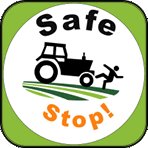
- Engage handbrake
- Controls in neutral
- Switch off engine (or turn off power)
- Remove key (or lock-off the power supply)
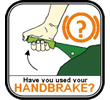
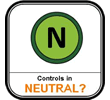
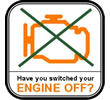
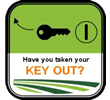
Follow Safe Stop:
- before leaving the driver's seat/operating position;
- when anyone else approaches;
- before anyone carries out maintenance, adjustments or deals with a blockage.
The images above have been developed by the Farms Safety Partnership. For more details of the Partnership's Safe Stop campaign visit their website.
Before you start
Before using a machine, consider the following:
- Is the machine you intend to use suitable for the job?
- Are all safety devices such as guards in place and working correctly?
- Are you (or the operator) properly trained to do this job/use this machine?
- Has the instruction manual for the machine been provided, read and understood?
- Is the right personal protective equipment (PPE) available and worn?
- Has a risk assessment been carried out?
- Has the work been properly planned and communicated to those who may be at risk?
- If two or more people are involved, has everyone understood what needs to be done and has a system of communication been agreed on?
Is the machine operator competent to do the job safely?
- Are all operators/workers trained to do this job?
- Workers should not use a machine unless they are properly trained and know how to use it safely.
- You should also check that any contractors you intend to use are competent to do the job.
- Don't forget that training is needed by casual or seasonal workers
- Is suitable clothing and footwear available and worn (including any PPE)?
- Safety boots should usually be worn when using machinery and operators should wear clothes that will not snag on machinery or controls.
- Any jewellery (including watches and rings) that might snag should be removed and long hair tied back so it does not get caught up in moving parts.
- Have operators been provided with relevant information?
- The operator should read and understand the instruction manual.
- They should also be provided with any relevant information to enable them to do the work safely, eg information from risk assessments.
- Where workers travel on the machine, eg a manned potato harvester, they should also receive adequate instructions and training.
Before using the machine
Before working with any machinery, carry out a basic check to make sure that it is in good working order and safe to use. This could include:
- Mechanical defects – pay particular attention to items such as brakes, wheels and tyres.
- Guards and other protective devices (eg PTO shaft guards) should be correctly fitted and maintained in good condition.
- Check that stopping devices are functioning correctly, eg emergency stops.
- All controls should be clearly marked to show what they do.
- If workers are to be carried on the machine ensure they can do so safely, eg check for safe means of access, working platforms have guard rails etc.
- Hitching and attachment points – check the machine has been safely attached to the towing vehicle. Pay attention to the condition of drawbar/pick-up hitch, and hitch rings, pins, clips etc.
- Carry out any pre-use checks as specified in the operator's manual.
- For self-propelled machines, make sure mirrors are clean and properly adjusted. Check any other reversing aids are working.
Using the machine
When you are working with a machine:
- Don't remove or defeat guards (eg by overriding safety devices) in order to allow the machine to work quicker or to avoid blockages or other problems.
- If guards become damaged or defective, stop work and take action to get them fixed. Don't leave it until later.
- Don't run the machine when the guards are removed.
- Replace all guards before making a test run and check the machine before restarting.
- Check for bystanders and warn them before you restart the machine.
- If the machine is to be checked again after the test run, repeat all safety procedures – especially Safe Stop
Dealing with blockages or other problems
- Always follow the Safe Stop procedure before carrying out any intervention.
- Secure anything which could fall on you, eg by using props or scotches on tailgates/doors.
- Secure anything which could move or rotate, eg by using chocks.
- Remember that energy may be stored eg in springs or hydraulics. Consider how will you stop this energy being released or release it safely.
- Use the right tools for the job. The wrong tools may not work, cause damage or create additional safety risks
- Remember that machine components may suddenly move when a blockage is cleared.
- Follow the manufacturer's instructions/procedures, eg as set out in the operator's manual.
- Use built-in ladders and other purpose-designed access points and platforms where provided. Where such facilities don't exist you will need to consider alternative safe means of access, eg with measures provided to prevent falls.
- When the job is finished, always replace the guards before running the machine.
- Check the machine over and make sure that people are well clear before restarting.
Finally, don't forget, NEVER:
- use a machine unless you know how to use it safely and have received suitable training;
- attempt to clear blockages or clean a machine unless you have followed the 'safe stop' procedure, the drive is disconnected, the machine is stationary and components have stopped;
- wear long chains, loose clothing, gloves or rings, or keep long hair loose, which may get caught up in moving parts;
- distract people who are using machines;
- mount or dismount from a moving tractor or other self-propelled machine.